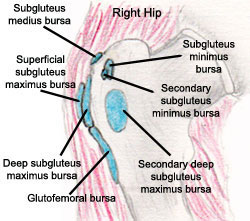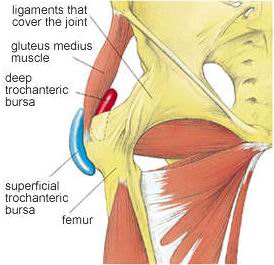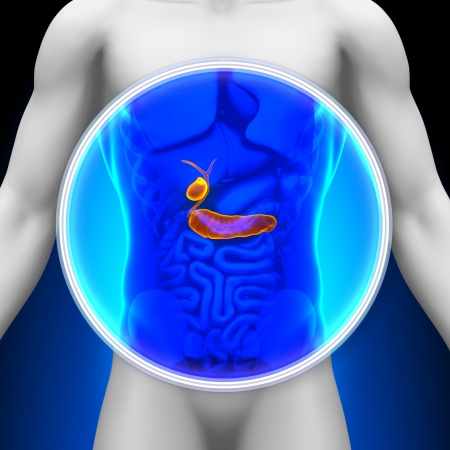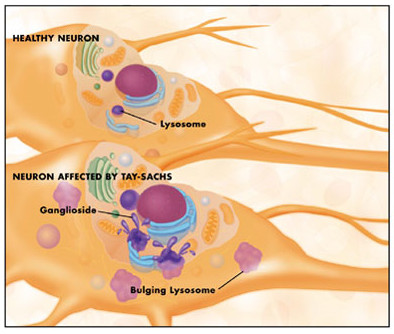Trochanteric Bursitis is a hip pain that is due to the inflammation of bursa which is a sac filled with fluid. This is located superficially at a thigh bone outside the point of the hip. When this part gets inflamed, a person may feel a lateral hip pain but not actually affected by the hip joint. If the inflammation goes deeper coming from a deeper sac at the top of thigh bone and on the gluteal muscle on the outer surface of the pelvis, this causes greater trochanteric bursitis.
Trochanteric Bursitis Causes
Picture 1 – Trochanteric Bursitis

Persons with trochanteric bursitis hip suffer from lack of sleep due to severe pain. As this causes tenderness of the outer hip, it makes harder for a patient to lie on the side where the inflammation is. This also causes a burning pain that often become worse and unmanageable.
Person who had injury to the point of the hip and those who give so much weight on either side of the hip like lying for extended period will most likely get this hip pain. Physical activities like climbing or standing for long period of time can cause overuse or injury to the joint areas which will further cause hip pain. Incorrect posture due to lumbar arthritis and other spine problems can also cause trochanteric bursitis. Some people may also have a tendency to suffer hip pain due to stress on the soft tissues resulted from abnormal joints or bones. Men and women especially those who are aging may likely have rheumatoid arthritis and gout which will further cause trochanteric bursitis hip. Other diseases and conditions that may lead to greater trochanteric bursitis are psoriasis, thyroid disease, hip surgery of prosthetic implants affecting the hip and hip bone spurs.
Trochanteric Bursitis Symptoms
Signs and symptoms of trochanteric bursitis can be easily detected and attributed to hip pain although one has not to take for granted other considerations. These may include:
- Hip pain – direct pain on the hip that radiates up to thigh and buttocks
- If you feel tenderness and pain when giving more weight on the affected area
- Stiffness of hip especially when you press it.
- Radiating and aggravating pain when getting up from a deeper seat, when walking or climbing up the stairs and giving more weight on the buttocks when getting up.
Trochanteric Bursitis Exercises
Some of the pain can be treated through rehabilitation exercises or trochanteric bursitis stretches. Exercise like Iliotibial band (ITB) stretches can be done in standing position with one foot crossed over the other while leaning away from the side being stretched. Feel the stretching at the lateral part of the hip and this should be done slowly and in a controlled and sustained manner. ITB stretch can also be done in a supine position. A wall squat may also be applicable. Stand up with a ball at your back leaning against the wall. Slowly squat down with your body on straight position making your thighs parallel to the floor. Hold for few seconds then slowly stand up sliding your back upward. Other common exercises are the hip extension in a supine position and leg raise while lying down. These both involve stretching the affected leg upward and holding it for few seconds while tightening the muscles on thighs.
These exercises strengthen the muscles but one has to perform them correctly to avoid further injuries and it is still best to consult medical practitioner beforehand.
Trochanteric Bursitis Treatment
Picture 2 – Trochanteric Bursitis

Trochanteric bursitis may not be critical and can be treated immediately if addressed properly. As the pain normally caused by overuse of the body parts affecting the hips, this means that one has to be very cautious in using properly the different body parts and give some rest in using such part. Some need to undergo trochanteric bursitis MRI (Magnetic Resonance Imaging) to find out deeper the cause of the problem. Through this different nerves affecting the hips will be seen and somehow identify those parts with trauma.
A medical practitioner may prescribe different medicines to cure the pain and to make the muscles affecting the area more relaxed. Some treatment may include occupational therapy or rehabilitation including different trochanteric bursitis stretches and exercises. Therapy also includes warm or cold compress depending on how stiff the muscles are or how inflamed the affected areas are, manual massage, ultrasound treatment to reach the inner muscles and nerves, traction to pull up and down the joints, and shock wave in severe cases. These activities stimulate the nerve and blood flow in order to achieve proper circulation. In some cases, a trochanteric bursitis injection is also given to put in the medicine directly on the affected nerves.
Trochanteric Bursitis Surgery
In case despite of all the above treatments may not be effective, there are some, although very rare who undergo trochanteric bursitis surgery. The surgery aims to remove the thickened bursa, bone spurs and to relax the stiffed muscles and tendons. Some procedures lengthen the tendon and some procedures involve removing a section of the tendon. This tendon rubs directly on the trochanter that causes greater trochanteric bursitis.
References:
http://my.clevelandclinic.org/disorders/bursitis/hic_trochanteric_bursitis.aspx
http://emedicine.medscape.com/article/87788-overview


